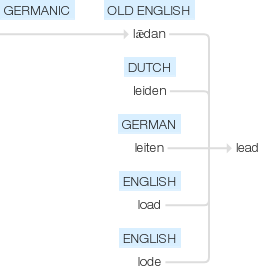Lead
Old English lǣdan, of Germanic origin; related to Dutch leiden and German leiten, also to load and lode.
wiktionary
From Middle English led, leed, from Old English lēad(“lead”), from Proto-West Germanic *laud(“lead”), borrowed from Proto-Celtic *ɸloudom, from Proto-Indo-European *plewd-(“to flow”). Cognate with Scots leid, lede(“lead”), North Frisian lud, luad(“lead”), West Frisian lead(“lead”), Dutch lood(“lead”), German Lot(“solder, plummet, sounding line”), Swedish lod(“lead”), Icelandic lóð(“a plumb, weight”), Irish luaidhe(“lead”)Latin plumbum(“lead”). Doublet of loth. More at flow.
From Middle English leden, from Old English lǣdan(“to lead”), from Proto-West Germanic *laidijan, from Proto-Germanic *laidijaną(“to cause one to go, lead”), causative of Proto-Germanic *līþaną(“to go”), from Proto-Indo-European *leit-, *leith-(“to leave, die”).
Cognate with West Frisian liede(“to lead”), Dutch leiden(“to lead”), German leiten(“to lead”), Danish and Norwegian Bokmål lede(“to lead”), Norwegian Nynorsk leia(“to lead”), Swedish leda(“to lead”). Related to Old English līþan(“to go, travel”).
lead
etymonline
lead (v.1)
"to guide," Old English lædan (transitive) "cause to go with oneself; march at the head of, go before as a guide, accompany and show the way; carry on; sprout forth, bring forth; pass (one's life)," causative of liðan "to travel," from Proto-Germanic *laidjanan (source also of Old Saxon lithan, Old Norse liða "to go," Old High German ga-lidan "to travel," Gothic ga-leiþan "to go"), from PIE *leit- (2) "to go forth."
Of roads, c. 1200. Meaning "to be in first place" is from late 14c. Intransitive sense, "act the part of a leader," is from 1570s. Sense in card playing, "to commence a round or trick," is from 1670s. Meaning "take the directing part in a musical performance or prayer" is from 1849. Related: Led; leading.
To lead with one's chin "leave oneself vulnerable in a contest" (1946) is a figure from boxing. To lead on "entice to advance" is from 1590s. To figuratively lead (someone) by the nose "guide by persuasion" is from 1580s, from draught animals (earlier lead by the sleeve, early 15c.). To lead (someone) a dance "compel through a course of irksome actions" is from 1520s.
lead (n.1)
heavy metal, Old English lead "lead, leaden vessel," from West Germanic *lauda- (source also of Old Frisian lad, Middle Dutch loot, Dutch lood "lead," German Lot "weight, plummet"), a word of uncertain origin. The name and the skill in using the metal seem to have been borrowed from the Celts (compare Old Irish luaide).
Figurative of heaviness at least since early 14c. American English slang lead balloon "dismal failure" attested by 1957, perhaps 1940s (as a type of something heavy that can be kept up only with effort, from 1904). Lead-footed "slow" is from 1896; opposite sense of "fast" emerged 1940s in trucker's jargon, from notion of a foot heavy on the gas pedal.
Meaning "graphite in a pencil" is from 1816 (see pencil (n.)). Black lead was an old name for "graphite," hence lead pencil (1680s) and the colloquial figurative phrase to have lead in one's pencil "be possessed of (especially male sexual) vigor," attested by 1902. White lead (1560s) was an old name for "tin."
As a name of a dull bluish-gray color, 1610s. From 1590s as figurative for "bullets." Lead oxide was much used in glazing, mirror-making, and pigments. In printing, "thin strip of type-metal (often lead but sometimes brass) used in composition to separate lines" from 1808, earlier space-line. Lead-poisoning is from 1848; earlier lead-distemper (1774).
lead (n.2)
c. 1300, "action of leading," from lead (v.1). Meaning "the front or leading place" is from 1560s. Johnson stigmatized it as "a low, despicable word." Sense in card-playing, "action or privilege of playing first," is from 1742; in theater, "the principal part," from 1831; in journalism, "initial summary of a news story," from 1912 (often spelled lede to distinguish it from lead (n.1), which formerly played a prominent role in typesetting. Boxing sense is from 1906. In jazz bands, from 1934 in reference to the principal parts; earlier it was used in music in reference to fugues (1880) of the part that takes off first and is "followed" by the others.
Meaning "direction given by example" (as in follow (someone's) lead) is by 1863, that of "a clue to a solution" is by 1851, both from the notion of "thing to be followed." As an adjective, "leading," by 1846. Lead-time "time needed to produce something" is 1945, American English.
lead (v.2)
early 15c., "to make of lead," from lead (n.1). Meaning "to cover with lead" is from mid-15c. In printing, 1841, also lead out.
lead (adj.)
"made of or resembling lead," late 14c., from lead (n.1).
